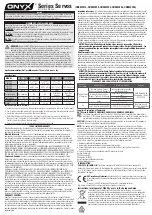
98
Installation and user guide
Rev: 4.0
NTT 240/460
Operation mode
6.15 Control topologies
Torque control:
it allows to control the motor torque managed by an analog input reference or a fieldbus command.
The provided torque reference is proportional to the rated torque of the motor.
According to the type of reference you work with, in Caliper software it is possible to set different parameters, for
example full-scale of analog input, optimal PID controlers for the application and the desired digital I/O.
For further information, please see
“6.15.1 Torque control” pag. 100
Speed control:
it allows to control the motor speed managed by an analog input, a frequency input or a fieldbus
command.
In I/O or Modbus operating mode, it is possible to use an additional analog auxiliary speed reference or a torque limit
reference. Therefore, it is possible to work in speed control mode, limiting the maximum torque output by imposing
a limit threshold.
Also a sensorles speed control is possible for motor with no feedback on board.
For further information, please see
“6.15.2 Sensored speed control” pag. 101
and
“6.15.3 Sensorless speed control” pag.
.
Position control - electronic gearbox:
it allows to set a transmission ratio between one or more motors, where a
slave axis, or “follower”, follows a master axis according to a preset ratio. This ratio is set in the slave drive and can be
freely changed.
The movement of the master is measured with an encoder, which signal is sent to the input of the follower drive,
that follows according the set ratio. The electronic gearbox replicates the mechanical transmission principle, in the
same way that happens in a mechanical reducer/gearbox or in a recirculating ball screw or in a rack or a pulley and
belt system.
The transmission with mechanical reduction allows to change speed, to increase torque and helps to match inertia
between motor and load. The electronic gearbox function, compared to mechanical reduction/gearbox, only
regulates the speed but with the advantage of allowing to freely change and to eliminate backlash and deterioration
typical of mechanical systems. It is possible to connect different slave axes to a single master axis, with different
electrial gear ratio.
When managing the electrical axis, it is important to calibrate the parameters of slave axis, especially response times,
in order to not let the slave to be in late than master dynamics.
For further information, please see
“6.15.4 Position control: electronic gearbox mode” pag. 103
.
Position control - electronic cam:
it is a feature that replicate the concept of mechanical cam. The mechanical cam
is an element with irregular shape (tipically ovoid) fixed to a rotating shaft of an axis and wihich moves another
mechanical parts that follows and reproduces the profile.
In the electronic cam, the mechanical regulation is replaced with electronics. A cam profile is defined via a X/Y table
up to 576 interpolation
points. Where the cam profile is fixed to master axis, in the electronic cam the profile is stored
in the drive. The “slave” axis receives the space reference of the “master” axis and replicates the profile described in the
table of X/Y points, generating the resulting motion. The signal of the master axis can come from an external encoder
or from the signal of a simulated encoder of another servo axis.
Up to 8 profiles are storable inside drive and they can be set via digital I/O; also it’s possible to freely change cam
profiles via Modbus RTU fieldbus.
The benefit of the electronic cam compared to the mechanical one is evident in the flexibility to manage more than
one profile, to be able to modify the profile very easily in any moment and not least the reduction of mechanical
backlash and the corresponding adjustments that follow.
For further information, please see
Summary of Contents for NTT 240
Page 129: ......
















































